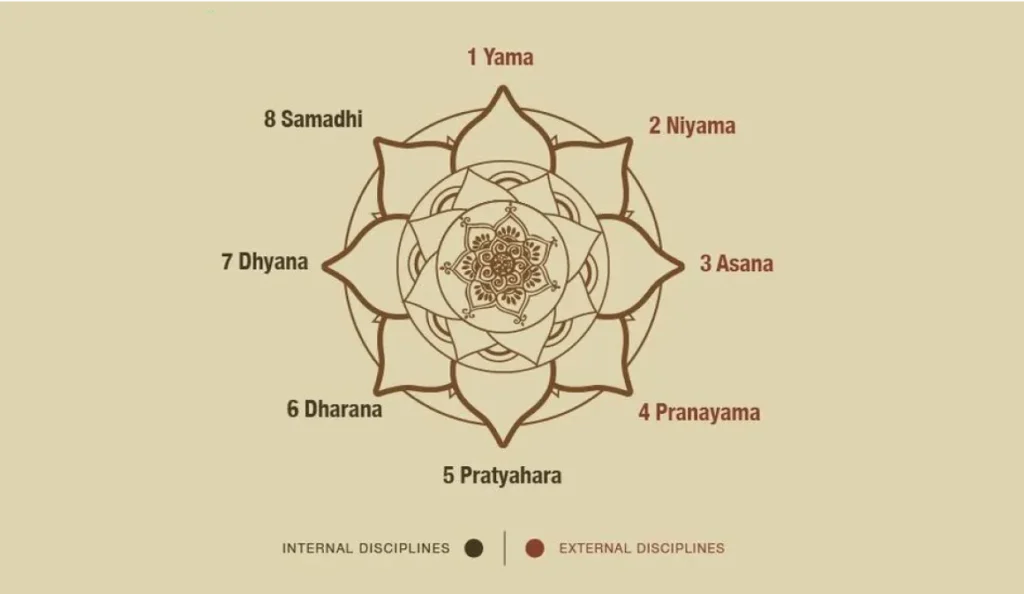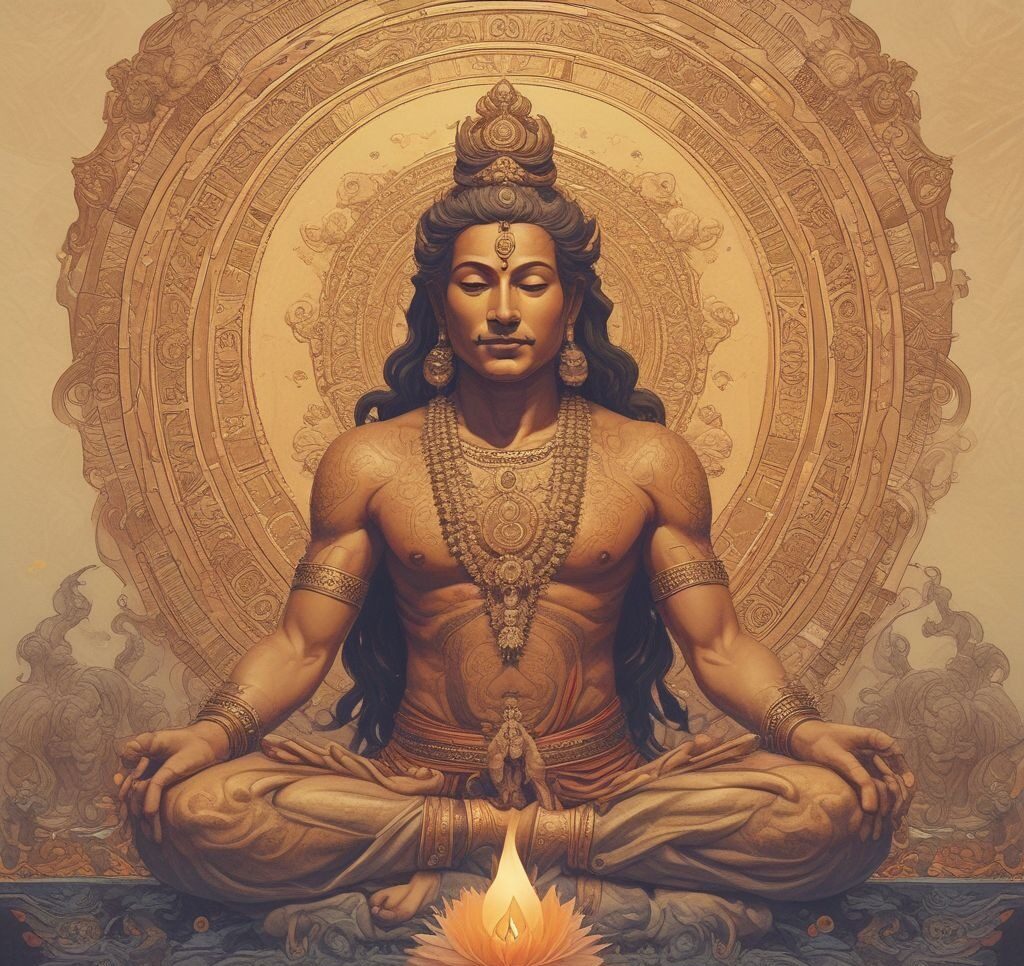A Journey through the 8 Limbs of Yoga
Though its physical postures make yoga so popular, there is much more to it than meets the eye. Comprising an all-encompassing structure called the Eight Limbs of Yoga, the age-old discipline has its roots in spiritual and philosophical traditions. You’re welcome to investigate each limb in this all-inclusive guide, showing how they work together to provide a route toward inner calm and personal growth.
1.अहिंसासत्यास्तेयब्रह्मचर्यापरग्रहाः यमा-Yama: Ethical Restraints
The first limb, Yama, stands for moral principles when dealing with others and the outside world. It establishes integrity on a personal and societal level. Yama is separated into five main ideas:
- अहिंसा -Ahimsa (NonViolence): The idea of Ahimsa, or non-violence, strongly emphasizes showing love and compassion for all living things. To practice Ahimsa, one abstains from doing, thinking, and speaking harm to others.
- सत्य -Satya (Truthfulness): Satya, which means truthfulness, promotes sincerity and genuineness. It’s about accepting reality in every connection and coordinating our words and deeds with ourselves.
- अस्तेय -Asteya (NonStealing): This value discourages avarice and promotes consideration for others’ belongings. It encompasses time and energy in addition to tangible objects.
- ब्रह्मचर्य-Brahmacharya (Moderation): Brahmacharya emphasizes restraint and moderation, especially regarding sensual pleasures. It is about balancing life and using energy properly.
- अपरिग्रह -Aparigraha (Non-Possessiveness): This concept encourages us to live freely by teaching us to let go of material attachments and learn to be content with what we have.
2.शौचसंतोषतपःस्वाध्यायेश्वरप्रणिधानानि नियमा :-Niyama :Personal Observances
Niyama emphasizes self-control and self-discipline after Yama. It directs our inner world, encouraging self-care and spiritual development by:
- शौच -Saucha (Purity): Saucha strongly emphasizes mental and physical hygiene. It entails keeping one’s surroundings tidy and one’s thoughts concentrated and precise.
- सत्य -Santosha (Contentment): Santosha promotes contentment and delight in the here and now, regardless of events beyond one’s control. It’s about being grateful for all of life’s flaws.
- अस्ते-Tapas (Discipline): Tapas represents self-control and tenacity. It’s the art of persevering through difficulties and developing inner fortitude with commitment and work.
- ब्रह्मचर्य-Svadhyaya (Self-Study): Svadhyaya entails studying religious books and engaging in introspection. It’s a path of self-discovery and increased spiritual understanding.
- अपरिग्रह -Ishvara Pranidhana (Surrender to the Divinge) : “Surrender to the Divine” is a principle that deals with giving up control to a greater force or collective awareness. It encourages modesty and faith in life’s divine order.
3.स्थिरसुखमासनम् -Asana: Physical Postures
Asana, which means “physical postures,” is the third limb. Although it is frequently connected to yoga, it prepares the body for meditation. Asanas develop awareness and presence in the body while enhancing strength, flexibility, and balance.
4.तस्मिन् सति श्वासप्रश्वासयोर्गतिविच्छेद: प्याम :-Pranayama: Breath Control
Breath control, or pranayama, refers to controlling and expanding the breath. Pranayama practitioners can attain mental clarity and control their prana, or energy flow. Methods that improve relaxation and concentration include breathing through your nose and deep abdomen.
5.स्वविषयासंप्रयोगे चित्तस्वरूपानुकारइवेन्द्रियाणां प्रत्॥-Pratyahara: Withdrawal of the Senses
The retreat of the senses from outside disturbances is referred to as aptyahara. It’s focusing inward and away from the external environment to promote greater self-awareness and introspection.
6.देशबंधश्चित्तस्य धारणा॥ -Dharana: Concentration
The discipline of concentration, or concentrated attention, is called Dharana. Training the mind to focus on a single object, breath, or mantra is part of this practice. These exercises discipline the mind and get it ready for meditation.
7. तत्र प्रत्ययक्तानाता ध्या -Dhyana: Meditation
The continuous, focused attention technique is known as Dhyana or meditation. When the mind is completely immersed in its topic of attention, a condition of profound, constant awareness and inner serenity occurs. Meditation fosters spiritual connection, peace, and understanding.
8.तदेवार्थमात्रनिर्भासं स्वरूपशून्यमिव समाधिः॥-Samadhi: Enlightenment
The last limb, Samadhi, symbolizes an advanced level of awareness or self-realization. In this ultimate practice that builds upon all prior practices, the practitioner experiences profound union with all existence and oneness with the divine. Samadhi’s attributes are happiness, transcendence, and a profound awareness of oneself.
Integrating the Eight Limbs
The Eight Limbs of Yoga provide a road map for a holistic lifestyle incorporating moral behavior, self-control, physical well-being, mental clarity, and spiritual awareness. By adopting these principles, individuals may have a well-rounded and satisfying life that promotes development in all facets of their identity.
Yoga is a profound journey that touches on all facets of living, not just a set of physical exercises. Every limb functions as a stepping stone toward a more profound relationship with the universe and oneself, resulting in a more peaceful and enlightened life.
Set off on this life-changing adventure and uncover the deep knowledge contained in the Eight Limbs of Yoga. As you delve into these ideas, you will discover the actual meaning of yoga, discovering a route to overall health and inner tranquility.







